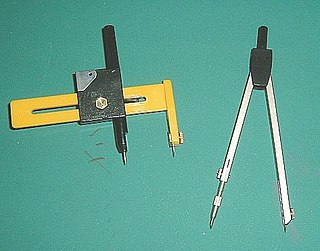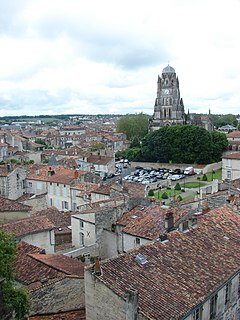
A galvanometer is an electromechanical instrument used for detecting and indicating an electric current. A galvanometer works as an actuator, by producing a rotary deflection, in response to electric current flowing through a coil in a constant magnetic field. Early galvanometers were not calibrated, but their later developments were used as measuring instruments, called ammeters, to measure the current flowing through an electric circuit.

Horace Bénédict de Saussure was a Genevan geologist, meteorologist, physicist, mountaineer and Alpine explorer, often called the founder of alpinism and modern meteorology, and considered to be the first person to build a successful solar oven.

A pair of compasses, also known as a compass, is a technical drawing instrument that can be used for inscribing circles or arcs. As dividers, they can also be used as tools to measure distances, in particular on maps. Compasses can be used for mathematics, drafting, navigation and other purposes.

Saintes is a commune and historic town in southwestern France, in the Charente-Maritime department of which it is a sub-prefecture, in Nouvelle-Aquitaine. Its inhabitants are called Saintaises and Saintais. Saintes is the second-largest city in Charente-Maritime, with 26,470 inhabitants in 2008. Its immediate surrounds form the second-most populous metropolitan area in the department, with 56,598 inhabitants, the majority of which is fertile, productive fields; a significant minority of the region remains forest, its natural state.

The Montreal Museum of Fine Arts is an art museum in Montreal, Quebec, Canada. It is the city's largest museum and is amongst the most prominent in Canada. The museum is located on the historic Golden Square Mile stretch of Sherbrooke Street.

Louise Catherine Breslau was a German-born Swiss painter, printmaker, and pastel artist active in France. She trained at the Académie Julian in Paris and exhibited at the salon of the Société Nationale des Beaux-Arts in Paris in the late nineteenth-century.

Jean-Daniel Colladon was a Swiss physicist.

The Musée zoologique de la ville de Strasbourg is a natural history museum displaying the zoological collections of the city of Strasbourg, managed and curated by the University of Strasbourg.

The Natural History Museum of Geneva is a natural history museum in Geneva, Switzerland.

Sciez is a commune in the Haute-Savoie department in the Auvergne-Rhône-Alpes region in south-eastern France. Sciez forms part of a transborder agglomeration known as Grand Genève.

The Bibliothèque de Genève, founded in 1559, was known as Bibliothèque publique et universitaire from 1907 to 2006.

Entremont is a 3.5 hectare archaeological site three kilometres from Aix-en-Provence at the extreme south of the Puyricard plateau. In antiquity, the oppidum at Entremont was the capital of the Celtic-Ligurian confederation. It was settled between 180 and 170 B.C., somewhat later than the inhabitation of other Gallic oppida, such as Saint-Blaise. The site was abandoned when it was taken by the Romans in 123 B.C. and replaced by Aquae Sextiae, a new Roman city founded at the foot of the plateau. By 90 B.C., the former oppidum was completely uninhabited.
Jules Favre was a Swiss zoologist, mycologist and geologist. He was the curator of the Natural History Museum of Geneva from 1915 to 1952.

George Adams the younger (1750–1795) was an English optician and writer. He was mathematical instrument maker to George III of England, succeeding his father George Adams in the post. He also made globes.

The Musée d'ethnographie de Genève is one of the most important ethnographic museums in Switzerland.

John Cuff was an important English scientific instrument maker, particularly of microscopes.

Jean-Gaspard Heilmann was an 18th-century French painter, author of popular landscapes, historical scenes and fine portraits. He was the first Mulhouse painter who enjoyed a certain notoriety in Paris.

Nicolas Cilins is an artist living in Geneva, Switzerland, working across the disciplines of visual arts, filmmaking, and performance art. His works are included as part of several public collections, such as the Kunstmuseum Bern in Switzerland, Fonds régional d'art contemporain in France, and the Institut für Film und Videokunst in Germany. In June of 2018, Cilins became a laureate of the Swiss Art Awards.




















